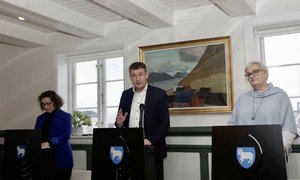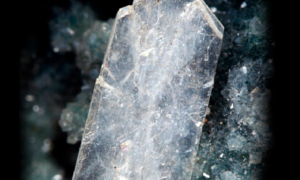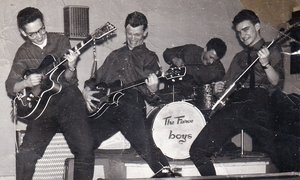JEREMY CRESSWELL
One word sums up the hunt for oil and gas on the Eastern Atlantic Frontier ? from Portugal to Lofoten off Norway ? slow. There are few commercial discoveries to show for the enormous effort made, except in the Norwegian sector where results obtained are the most promising to date.
And yet, when drilling for oil offshore Faroes began last year, doubtless many citizens were hoping for an instant bonanza. Predictably, that boom did not materialise. No matter how much success there is during the pioneering phase, first commercial oil/gas will not flow for at least four to five years.
It happens that one of the three exploratory wells drilled during the first Faroes offshore drilling season encountered what could ultimately prove to be viable quantities of gas/gas condensate ? Marjun (6004/16-1z).
More than a year gas passed since Hess announced that both light oil and gas had been located over a gross interval of approximately 170m in Palaeocene sediments. Located in 950m of water, close to the UK/Faroe boundary in the White Zone, the well was drilled to a total depth of 4275m in a deepening operation, after reaching the commitment depth of 3830m.
While the other two wells - Longan (Statoil) and Svinoy (BP) - were dry holes, they provided a great deal of valuable information, as did the nearby disappointing Assynt well drilled last year by BP in the UK portion of the White Zone.
While there has been no drilling in Faroese waters this year, the recently completed UKCS 204/16-1 Amerada Hess-operated well will contribute valuable information, as the objective was to test whether Marjun extended into UK territory.
This well was spudded on the Cambo tract by the West Navion drillship on 1 September in the Faroe-Shetland Trough and was plugged and abandoned on 17 October. Drilled to a total depth of 4275m, the well encountered hydrocarbons but not in sufficient quantities to justify a drill stem test and so was a disappointment.
Just now, Agip is drilling the 164/27-1 well on the Rockall Trough Antaeus prospect, close to an earlier, apparently unsuccessful wildcat. The Antaeus well will also provide valuable data for the Faroese effort, whether or not it is successful.
Naturally, there is no telling how lucky Agip, in partnership with Foroya Kolvetni, will be next year when it spuds the Marimas prospect (licence 002) using the drillship Belford Dolphin. Geological analysis points to the right conditions for hydrocarbons to be present, but will they be there? Will there be a sealing mechanism to contain the hoped for prize?
The Marjun success represents a one in three hit rate for the Faroes. This is good for the European sector of the Atlantic Frontier, especially when set against UK west of Shetland, where less than a handful of fields are producing or under development (namely Foinaven and Schiehallion/Loyal, with Clair scheduled to come onstream in 2004), and elsewhere in Atlanto-European waters, with the qualified exception of Norway.
The French, Spanish and Portuguese sectors of the frontier have been singularly disappointing. One has to travel as far south as Mauritania in North-west Africa before viable finds are recorded, and, beyond that, there is the West Africa bonanza, which for now seems unstoppable.
On the opposite side of the Atlantic to the North Sea, the story of oil has also been slow to unfold, though the potential of Eastern Canada is said to be considerable. And, in Greenland, there is nothing to show for efforts made to date, with only one company seeking a permit in the latest licensing round.
In recent years it has become increasingly clear that hydrocarbons are present along much of the eastern margin of the Atlantic, generally in deep water, with oil accumulations often found in geologically shallow formations. Discoveries fitting this description include Girassol - Angola, newly discovered Chinguetti ? Mauritania, the non-commercial Connemara find west of Ireland; and Clair, Foinaven and Schiehallion west of Shetland. In Norwegian waters, the More and Voring Basins are the primary focus for deepwater Atlantic Margin discoveries such as Skarv (block 6507/4).
In the case of Skarv, which BP proposes to develop at a cost of some $1.3-1.6 billion, the company earlier this year postponed tenders for the front-end engineering and design study regarding the field?s development, pending clarification of how the gas will be transported to market. BP has prequalified five companies for the Skarv FEED, namely ABB Offshore Partners, AkerKværner, Amec, and Halliburton KBR.
The plan is to develop Skarv using 21 subsea wells and subsea production facilities tied back to the nearby Snadd and Grasel fields and produce to an FPSO. BP estimates Skarv reserves to be some 110million barrels of oil and 67billion cu.m of gas. It is still planned that the field be brought onstream by late 2005.
On the Norwegian exploration front, among the most interesting frontier concessions awarded in the recent 17th licensing round is a prospect known as Fles Nord. This is thought to harbour large gas resources and is therefore of particular interest to Norsk Hydro, which also controls the stunning Ormen Lange discovery ? the largest gas find made since Troll.
The Fles Nord blocks are located at water depths of 900m, centrally situated in the Voring Basin, approximately 150km north-west of the Åsgard field on the Haltenbank.
Despite its supposed potential, it has been a long, expensive, dangerous and all too often disappointing slog to get anywhere on the European portion of the Atlantic Margin.
Take the French sector as an example where efforts made have yielded nothing worthwhile. Thirty years ago, high hopes on France?s Atlantic Shelf led to the drilling of 24 wells in the Gulf of Gasgogne. In 1995 there was renewed interest, which resulted in the Antares discovery on the Bon Maritime permit (Bay of Biscay). But Elf ditched it because of poor reservoir quality, unacceptable oil prices and high cost of extracting oil from such a remote location.
But hope springs eternal and the Portuguese sector is a case in point, as the Lisbon government?s latest offshore licensing round comprising 14 blocks seems to be attracting significant oil company attention.
The round is scheduled to close on 2 December. It has been reported that 20 companies have noted interests in bidding, with shallow water block 14 likely to receive the most attention, as it is close to Spanish territory and the Repsol-YPF operated Poseidon gasfield.
Of the 14 blocks; four are in the Estremadura/South Peniche area, six in Alentejo/Sagres, and four in the Algarve Basin. Geologically, the acreage lies in an area that is considered similar to those oil-producing areas of West Africa and Eastern Canada.
That said no commercial discoveries have been made offshore Portugal. Noteworthy is the failure by Desire Petroleum to find anything worthwhile. Chastened by the inconclusive first Falklands exploration drilling campaign late 1997/early 1998, the inexperienced London stock exchange-listed company wasted a considerable amount of shareholders? money as a member of a partnership lead by Mohave that drilled the Lusitania Basin - Aljubarrota prospect in 2000 and again in 2001. The adventure proved a commercial failure and resulted in Desire backing away.
In its 2001 annual report, Desire said prospects identified in the Lusitania Basin were large and could contain ?substantial reserves of hydrocarbons?. Gas was encountered with the Aljubarrota-2 and 3 wells, but they failed to flow due to the lack of fracture development in the Brenha limestone reservoir. One hopes that others will be more successful in the future.
While new generation technologies have of late enhanced the chances of success, accessing the Frontier?s enigmatic prize remains difficult and, even when a potentially viable discovery is made, initial optimism can quickly give way to pessimism.
It has to be hoped this is not the fate of the Dooish well drilled by Enterprise (now part of Shell) in the Irish portion of the Rockall Basin this year. While Enterprise/Shell has disclosed the bare minimum of information, the Dublin government has signalled that the company may have located oil in such quantities that it could transform Ireland?s offshore energy prospects.
John Browne, the Minister of State for Marine and Natural Resources told the Irish media: ?While it is too early to judge their economic significance, the results clearly demonstrate the presence of a working petroleum system and as such have profound implications for the future exploration of frontier areas offshore Ireland.?
After so many years of disappointment, Dublin is keen to promote Ireland?s offshore potential at every possible opportunity.
Frustratingly, the early onset of winter weather curtailed Dooish, but not before sufficient initial results had been gathered to encourage the company to say tantalisingly that it will ?return to the area as soon as possible next year
Dooish (12/2-1) is located 125 km northwest of Donegal in the Rockall Basin, in 1478m of water. This is the second deepest water depth in which a well has ever been drilled in Irish waters. It sits midway between the Amoco-operated 12/13-1A (TD 2869m) duster of 1979 and last year?s Errigal wildcat drilled by Enterprise on block 5/22 close to the maritime border with the UK. This well was completed as a tight hole after 34 days at a TD of 4070m, since when nothing has been disclosed.
While the industry awaits word on Errigal, the other two wells drilled in 2001 were failures, namely
Statoil?s 35/21-1 wildcat on the Sarsfield prospect located on second-round frontier acreage in the Porcupine Basin, and the EDC Samedan-operated 63/4-2 well drilled in the Fastnet Basin. Enterprise also received a scare with a disappointing appraisal well drilled in the Corrib gasfield, the development of which is ongoing.
Clair, located in 1977, was the first UKCS Atlantic Margin commercial discovery, though it was not declared as such until late 2001 when operator BP and licence partners in the giant 4billion-barrel heavy crude field agreed a project based around exploiting a core area with recoverable reserves estimated at 270 million barrels of heavy crude.
Aside from Clair and a minor discovery or two like Victory (ChevronTexaco), it took more than 100 exploration wells drilled west of Shetland before, in 1992, the Foinaven field with recoverables in the 250-500 million barrels range was located in 400-600m of water 1992. A year later the Schiehallion/Loyal group of fields with a smilar reserves potential was found in 375m.
While little is in the public domain regarding estimated reserves for the slightly later and nearby Suilven discovery, this too is believed commercial. But Solan/Strathmore now appear marginal as satellite tie-ins to Foinaven/Schiehallion. While Solan/Strathmore have been the focus of development proposals, these have gone cool.
There is also talk of a number of gas finds that may or may not make the grade at some future date. But Conival, a gas prospect probed by BP and which attracted much analyst and media interest, turned out to be a huge disappointment.
Excluding the Rockall Basin, where around 10 wells have been drilled, the UK west of Shetland exploration tally is around 130 wells, plus a further 50 or so appraisal wells.
Once thought to offer huge potential, west of Shetland reserves now fall a long way short of early estimates. In its 1990 Brown Book, the UK Department of Trade and Industry gave high-end reserves estimates of 730million tonnes of oil and 655billion cu.m of gas, plus a further 520million tonnes of oil for ?west of Scotland (includes Rockall Trough).
By 1991, the high-end estimates had shrunk to 155million tonnes proven and probable for oil, plus a further 95million tonnes ?possible and additional?. The gas figures were 35billion cu.m proven and probable, plus 60billion cu.m possible and additional. West Scotland is omitted.
This year?s Brown Book points to west of Shetland oil reserves of as much as 420million tonnes and gas up to 550billion cu.m. West of Scotland is 400million tonnes and 400billion cu.m. The figures are based on data gathered during the 1991 mapping and drilling programmes and are probably the most relevant to the Faroes.
The message of this review is surely that a great deal of patience will be required before the Faroes energy prize is realised ? if it is every realised.
ENDS














